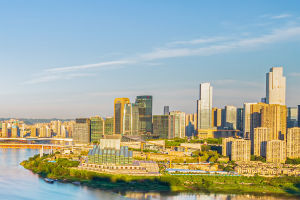Skyscrapers, also known as super high-rise buildings or very tall multi-storey buildings, were originally one or twenty-story buildings, but now generally refer to tall buildings with more than forty or fifty floors. With the development of high-rise buildings in different places, the definition of skyscrapers also varies.
In Japan and France, buildings exceeding 60 meters belong to super high-rise buildings, while in the United States, buildings above 152 meters (500 feet) are generally considered skyscrapers.
Buildings soaring into the sky have long been envisioned. But before the 19th century, due to the limitations of materials and technical conditions, and because there was no such need for social life, houses built rarely exceeded five or six floors.
In the 19th century, the development of industry and the living conditions in big cities required an increase in building height.
Early tall buildings mainly appeared in Chicago, USA. In 1885, the first home insurance company building was built on a frame structure in Chicago. This is an 11-story building designed by architect Janney, who changed the structure of traditional buildings by accident.
Bricklayers went on strike while construction was underway on the building, temporarily halting work. For an early completion, Gianni used a steel frame structure on the interior and exterior walls. In this way, a new type of architecture came out.
However, as skyscrapers are built higher and higher, many disadvantages have also begun to show. Iconic or not, not everyone likes skyscrapers, especially shiny new ones. Architecture critic David Brusset said such towers created "aesthetic pollution."
"Somehow, the taller the buildings, the smaller the city. The smaller the city. The urban canyon under the tall buildings bores and frustrates commuters who walk through it."
With the destruction of the World Trade Center towers (526.3 meters) in New York in 2001, one could not help but cast doubt on the safety of skyscrapers. Indeed, it is very difficult for people living and working in skyscrapers to escape in case of earthquake or fire.
Moreover, environmental protection organizations have recently pointed out that skyscrapers will cause a series of environmental problems and affect the survival of humans and other species.
First, skyscrapers cause an urban canyon effect. The urban canyon effect means that due to geometric effects, the glass curtain walls of high-rise buildings, especially skyscrapers, will absorb and reflect a large amount of sunlight, causing the surrounding temperature to be higher than in other areas. This can have a significant impact on the microclimate and biodiversity of the surrounding area.
Skyscrapers also have an impact on urban traffic and resource consumption. Because of the limited land occupied by skyscrapers, transportation and public facilities around them tend to be restricted and congested, leading to traffic problems and resource shortages.
In addition, the construction and operation of skyscrapers require a lot of resources and energy, such as steel, cement, and electricity. The consumption of these resources and the emission of energy can also have negative impacts on the environment, such as air pollution and climate change.
As iconic buildings and urban forms, skyscrapers have important historical and cultural value, but they also face many challenges and problems. Future development needs to better meet people's needs for urban space and quality of life on the premise of ensuring safety and environmental protection.
New technologies and materials can help reduce the negative impact of skyscrapers on the environment and the surrounding area. For example, the use of green building materials and sustainable energy sources can reduce energy consumption and environmental pollution. Smart designs and innovative engineering techniques can also improve safety and accessibility in skyscrapers.
Despite these challenges, skyscrapers remain an important part of modern urban landscapes, and their historical and cultural significance cannot be ignored. With continued innovation and advancements in technology, skyscrapers will likely continue to grow taller and become even more complex, providing us with unique and awe-inspiring architectural feats.
However, it is important to address the environmental and safety concerns associated with these buildings to create sustainable and livable cities for future generations.


